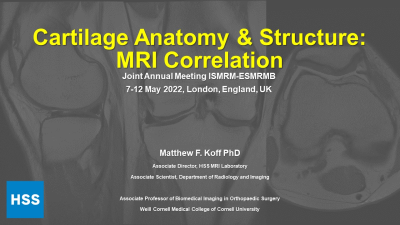Weekend Course
MRI of Cartilage
Joint Annual Meeting ISMRM-ESMRMB & ISMRT 31st Annual Meeting • 07-12 May 2022 • London, UK

| Cartilage I | |||
| 08:00 |  |
Cartilage Anatomy & Structure: MRI Correlation
Matthew Koff
Correlates to morphologic and quantitative MRI assessments of articular cartilage will be presented |
|
| 08:25 | The Role of MRI of Cartilage in Improving Clinical Management in Orthopedics: A Surgeon's Perspective
Daniel Saris
Cell based surgical repair of cartilage has progressed to a reliable therapeutical option. advanced imaging modalities with automated segmentation and disease focused presentation of relevant findings that correlate to patient's disease and monitor progress of healing would represent tremendous patient centered progress
|
||
| Cartilage II | |||
| 08:50 | Morphologic MR Imaging of Cartilage in Trauma & OA
Akshay Chaudhari
The lecture will present various different imaging methodologies that have been used for morphological and qualitative assessment of articular cartilage. We will discuss the benefits and challenges of these imaging techniques separately for clinical use-cases in assessing cartilage trauma as well as in research-focused studies evaluating cartilage degeneration in osteoarthritis.
|
||
| 09:15 | Quantitative MRI of Cartilage: Relaxometry
Victor Casula
Quantitative relaxometry extends MRI beyond anatomical imaging and provides information on the physical structure, composition, and functional state of cartilage. Quantitative MRI techniques reflect the interaction of water with cartilage macromolecules and allow detection of early biological changes in cartilage. This part of the educational course is an overview of the most established techniques for quantitative relaxometry of cartilage, namely T2, T2* and T1ρ mapping and dGEMRIC. We will review their relationship with physiological properties of cartilage and give a description of their potential value as diagnostic biomarkers followed by a discussion of the limitations and challenges towards clinical applications.
|
||
| 09:40 | Break & Meet the Teachers |
||
| Cartilage III | |||
| 10:00 | Quantitative MRI of Cartilage: Diffusion, gagCEST & Sodium
Vladimir Juras
Osteoarthritis (OA) is a disease affecting the entire joint, including articular cartilage, subchondral bone, synovial tissues and menisci. Early OA stages in cartilage are manifested by a loss of glycosaminoglycans and disruption of collagen matrix. Quantitative MRI techniques provide an useful tool for detection of the structural changes. Here, the diffusion weighted MRI, gagCEST and sodium MRI are discussed, including each method pitfalls and advantages, as well as the overview of (clinical) applications.
|
||
| 10:25 | MRI of Cartilage: Ex Vivo & Animal Models with Clinical Correlation Video Unavailable |
||
| Cartilage IV | |||
| 10:50 | Translation of Quantitative MR of Cartilage from Research to Clinical Care
Thomas Link
In order to institute quantitative cartilage MRI in clinical practice a number of requirements need to be met. First of all, it is essential to define the exact clinical indications for quantitative imaging and how they would impact patient care. Second, image acquisition and analysis need to be standardized and meet clearly defined claims including reproducibility. Finally, sequences need to be approved by regulatory agencies and be available as a product from manufacturers. In this presentation we will discuss these different steps.
|
||
| 11:15 | 7T MRI for Cartilage Video Unavailable |
||
The International Society for Magnetic Resonance in Medicine is accredited by the Accreditation Council for Continuing Medical Education to provide continuing medical education for physicians.